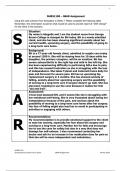Resume
Summary Enzyme kinetics
- Cours
- Établissement
This summary covers all the details about enzyme kinetics and essential equations. It covers the Mechaelis-Menteen, Km, catalytic efficiency, how to analyse kinetic data/curves, Lineweaver-Burke plot, Hofstee-Eadie plot, Hanes-Woolf plot, and calculation from kinetic data.
[Montrer plus]






